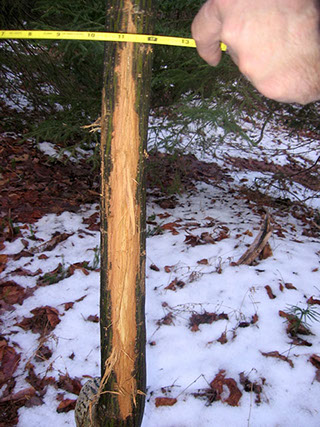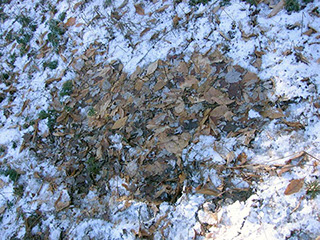Trailing Wildlife
A recent antler rub is sometimes all we need to know we're still on the trail. To follow a trail freshly laid by a wild animal, let’s say a buck or a sow, until we see the animal; to move silently along the trail, taking advantage of cover and the breeze so that the animal is never alerted to human presence, until we can watch as it nibbles vegetation or rests in its bed – that is what trailing is about.
To follow a trail freshly laid by a wild animal, let’s say a buck or a sow, until we see the animal; to move silently along the trail, taking advantage of cover and the breeze so that the animal is never alerted to human presence, until we can watch as it nibbles vegetation or rests in its bed – that is what trailing is about.
Traditionally, it is the hunter’s skill. Now, it is increasingly useful to wildlife researchers, biologists, park rangers, citizen scientists and anyone who wants to observe wildlife closely and sense what the Wild requires.
To see an animal by trailing it, one must practice on a great many trails. It is the Basic Practice by which one learns trailing, and there is no substitute. The "Trailing" section of this website describes the anatomy of a more full-bodied training, called Trailing Wildlife, written by Nate Harvey, a Senior Tracker and Evaluator with CyberTracker Conservation. None of the training elements, however, can replace your own “dirt time”. The aim here is to offer suggestions so that you can stay safe and make the best use of your time in the field. Review the introductory pages that follow, practice the exercises, and contact Nate for more information on the full curriculum.
 A moose bed.It is important to note at the start that trailing can take us into extremely perilous territory, places that are, for example, home to grizzly bears, rhinos, cobras or crocodiles. Let us not forget, though, that ticks and poison ivy also can cause great distress. Identifying hazards, knowing how to avoid them and learning how to respond to them when they can no longer be avoided are all an essential part of knowing how to trail wildlife successfully.
A moose bed.It is important to note at the start that trailing can take us into extremely perilous territory, places that are, for example, home to grizzly bears, rhinos, cobras or crocodiles. Let us not forget, though, that ticks and poison ivy also can cause great distress. Identifying hazards, knowing how to avoid them and learning how to respond to them when they can no longer be avoided are all an essential part of knowing how to trail wildlife successfully.
This training does not identify for you the hazards of your area nor tell you in every case how to respond, since dangers vary so much from place to place.
It is up to you to identify and list all the hazards that may be present in your area and to research best practices for how to avoid or respond to each. Think outside the box; include widow makers, for example, if you live in a forested environment.
When considering the best way to avoid the dangers that certain animals present, some people may decide not to follow their trails. Hit that trail when you’re ready, and know that you can find ways to be there so that you and the animal can both be safe.
© Nate Harvey, 2015
